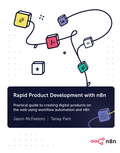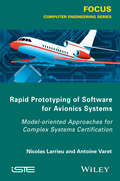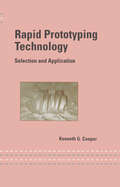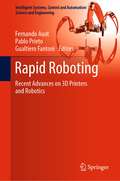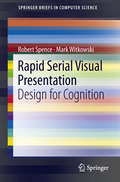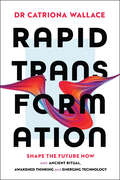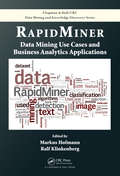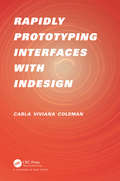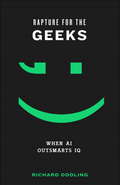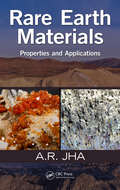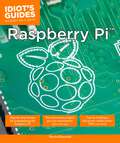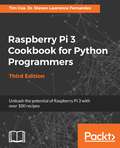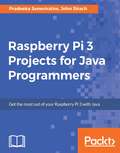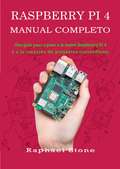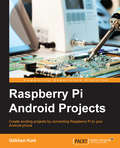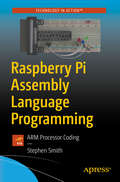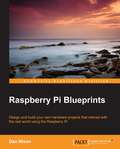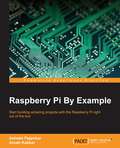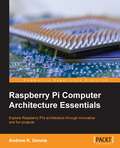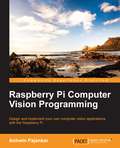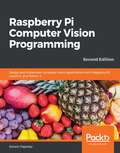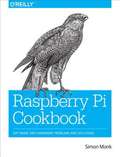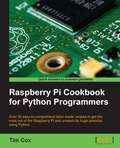- Table View
- List View
Rapid Product Development with n8n: Practical guide to creating digital products on the web using workflow automation and n8n
by Tanay Pant Jason McFeetorsLearn n8n to reduce costs, improve efficiency, and increase productivity in your development processKey FeaturesDiscover best practices, advantages, and case studies from the n8n teamExplore practical techniques to build market-ready low-code solutions using n8n and BubbleLearn how to develop enterprise-scale web applications without any engineering supportBook DescriptionExplore how n8n enables you to connect different systems and cloud services without having to hire specialists or develop technical skill sets across multiple tech stacks. This book will show you how n8n can reduce the time required to develop new products, helping you bring them to the market quickly compared to building a whole development team.This official n8n guide will assist you with adopting and integrating n8n in your development workflow in the best possible manner. You'll begin by learning where n8n fits in the tech stack of your business and how it provides opportunities for reducing cost as well as increasing efficiency and revenue. Once you've identified opportunities where you can leverage n8n's connectivity and automation functionality within your working environment, you'll progress to building an n8n-based toolset that will increase the profitability of your operations.By the end of this product development book, you'll be able to identify real-world opportunities to generate income, improve efficiencies, and then build tools to capitalize on these opportunities.What you will learnIdentify opportunities to use n8n in your organization and develop a business use caseUnderstand how to use APIs and webhooks with n8nBuild a custom production-ready API endpoint for your n8n applicationsCreate an end-to-end web application by connecting an API to the frontendAutomate your digital processes based on time and external triggersDevelop complex business applications rapidly using a low-code approachWho this book is forThis book is for web developers and low code enthusiasts who have basic knowledge of JavaScript as well as some basic understanding of web concepts such as APIs and webhooks. Developers looking for a digital platform to enable rapid prototyping and automation for their workflow will find this book useful.
Rapid Prototyping Software for Avionics Systems
by Nicolas Larrieu Antoine VaretThe design, implementation and validation of avionics and aeronautical systems have become extremely complex tasks due to the increase of functionalities that are deployed in current avionics systems and the need to be able certify them before putting them into production. This book proposes a methodology to enable the rapid prototyping of such a system by considering from the start the certification aspects of the solution produced. This method takes advantage of the model-based design approaches as well as the use of formal methods for the validation of these systems. Furthermore, the use of automatic software code generation tools using models makes it possible to reduce the development phase as well as the final solution testing. This book presents, firstly, an overview of the model-based design approaches such as those used in the field of aeronautical software engineering. Secondly, an original methodology that is perfectly adapted to the field of aeronautical embedded systems is introduced. Finally, the authors illustrate the use of this method using a case study for the design, implementation and testing of a new generation aeronautical router.
Rapid Prototyping Technology: Selection and Application
by Kenneth CooperReviews operation principles and methods for most Solid Freeform technologies and historical systems data. Illustrates the uses and mechanical details for a number of systems, including JP-System 5, Ballistic Particle Manufacturing, Fused Deposition Modeling, Laminated Object Manufacturing, Stereolithography, and Selective Laser Sintering.
Rapid Roboting: Recent Advances on 3D Printers and Robotics (Intelligent Systems, Control and Automation: Science and Engineering #82)
by Fernando Auat Pablo Prieto Gualtiero FantoniThis book summarizes recent advances in robotics using 3D printers and rapid prototyping as a concept development tool. The book is focused on industrial applications, educational aspects, rehabilitation, and other related topics. In particular, the book is intended to offer the reader a smooth yet deep introduction to the use of 3D printers and rapid prototyping techniques as a solution to robotics and mechatronics problems, highlighting successful case studies.
Rapid Serial Visual Presentation
by Robert Spence Mark WitkowskiA powerful new image presentation technique has evolved over the last twenty years, and its value demonstrated through its support of many and varied common tasks. Conceptually, Rapid Serial Visual Presentation (RSVP) is basically simple, exemplified in the physical world by the rapid riffling of the pages of a book in order to locate a known image. Advances in computation and graphics processing allow RSVP to be applied flexibly and effectively to a huge variety of common tasks such as window shopping, video fast-forward and rewind, TV channel selection and product browsing. At its heart is a remarkable feature of the human visual processing system known as pre-attentive processing, one which supports the recognition of a known image within as little as one hundred milliseconds and without conscious cognitive effort. Knowledge of pre-attentive processing, together with extensive empirical evidence concerning RSVP, has allowed the authors to provide useful guidance to interaction designers wishing to explore the relevance of RSVP to an application, guidance which is supported by a variety of illustrative examples.
Rapid Transformation: Shape the Future Now with Ancient Ritual, Awakened Thinking and Emerging Technology
by Catriona WallaceOld leadership models won't solve tomorrow's problems. The time for rapid transformation is now. Faster than ever before, our world is moving from one extreme to another. How can we respond in a way that creates meaningful change for a better future? In this groundbreaking book, Dr. Catriona Wallace reveals a pathway for implementing a powerful shift in perspective and leadership. Rapid Transformation combines ancient wisdom with emerging technologies, offering practical tools to rise above crisis and create a safer, more sustainable tomorrow. Through science-backed research, personal experience and compelling storytelling, Rapid Transformation will help you expand your vision, foster healing and lead significant evolution. It introduces three essential pillars for guiding individuals, organisations and society through uncertain times: Learn how ancient and indigenous rituals can help you ground your leadership, navigate uncertainty and inspire meaningful change. Unlock clarity, connection and purpose through altered states of consciousness, using techniques such as plant medicine and psychedelics to open new pathways for leadership. Discover how to leverage the power of AI to accelerate visionary leadership and unlock tomorrow's potential. Rapid Transformation is a one-of-a-kind blueprint for leaders who are ready to step into their highest potential and better serve themselves, their communities and the world. It is a must-read for trailblazers, entrepreneurs, disruptors and anyone seeking the practical wisdom — and pioneering ideas — they need to navigate change and effect transformation now. Are you ready to lead the change? This book will show you the way.
RapidMiner: Data Mining Use Cases and Business Analytics Applications (Chapman And Hall/crc Data Mining And Knowledge Discovery Ser. #33)
by Markus HofmannPowerful, Flexible Tools for a Data-Driven WorldAs the data deluge continues in today's world, the need to master data mining, predictive analytics, and business analytics has never been greater. These techniques and tools provide unprecedented insights into data, enabling better decision making and forecasting, and ultimately the solution of incre
RapidWeaver 5 Beginner's Guide
by Joe WorkmanThis book is a step-by-step tutorial that includes all the project files and complete source code for all of the webpages created. Each tutorial has concise steps that will allow you to walk through them easily. Most tutorials will have an optional exercise for the more advanced users to take things to the next level. If you are a novice wanting to build your first website or an experienced user looking for a better way to develop your existing websites, then this book is for you. This book is perfect for iWeb users that are looking for something better. It's also great for advanced users who use applications like Dreamweaver and are looking for a simpler way to develop websites without sacrificing the ability to get into the code. Using this book, you can build entire websites without writing a single line of code. But if you know a little web programming then you will be able to take your websites to the next level.
Rapidly Prototyping Interfaces with InDesign
by Carla Viviana ColemanRapidly Prototyping Interfaces with InDesign guides readers to learn to create a wide range of interfaces, from mobile to desktop. With InDesign, interface prototyping takes minutes instead of days. This book is code-free and entirely hands-on with InDesign tools. This book acts as a guide for how to prototype user interfaces with InDesign, using diagrams, illustrations, and screen shots. This illustrated book concerns the creation and prototyping of eBooks, eMagazines, websites, desktop apps and movile apps. InDesign is an important tool for rapid prototyping, as no coding is involved. <P><P>Key Features <li>No available book provides this information. <li>The reader will learn how to prototype a wide range of interfaces for both desktop and movile platforms. <li>The book will include software screen shots and guide the reader step by step. <li>The example prototypes will be interactive. Users can test them using interactive devices, such as desktop computers, tablets or mobile phones. <li>The reader will learn how to prepare an effective portfolio and resume.
Rapture for the Geeks: When AI Outsmarts IQ
by Richard DoolingWill the Geeks inherit the earth? If computers become twice as fast and twice as capable every two years, how long is it before they're as intelligent as humans? More intelligent? And then in two more years, twice as intelligent? How long before you won't be able to tell if you are texting a person or an especially ingenious chatterbot program designed to simulate intelligent human conversation? According to Richard Dooling in Rapture for the Geeks--maybe not that long. It took humans millions of years to develop opposable thumbs (which we now use to build computers), but computers go from megabytes to gigabytes in five years; from the invention of the PC to the Internet in less than fifteen. At the accelerating rate of technological development, AI should surpass IQ in the next seven to thirty-seven years (depending on who you ask). We are sluggish biological sorcerers, but we've managed to create whiz-bang machines that are evolving much faster than we are. In this fascinating, entertaining, and illuminating book, Dooling looks at what some of the greatest minds have to say about our role in a future in which technology rapidly leaves us in the dust. As Dooling writes, comparing human evolution to technological evolution is "worse than apples and oranges: It's appliances versus orangutans. " Is the era of Singularity, when machines outthink humans, almost upon us? Will we be enslaved by our supercomputer overlords, as many a sci-fi writer has wondered? Or will humans live lives of leisure with computers doing all the heavy lifting? With antic wit, fearless prescience, and common sense, Dooling provocatively examines nothing less than what it means to be human in what he playfully calls the age of b. s. (before Singularity)--and what life will be like when we are no longer alone with Mother Nature at Darwin's card table. Are computers thinking and feeling if they can mimic human speech and emotions? Does processing capability equal consciousness? What happens to our quaint beliefs about God when we're all worshipping technology? What if the human compulsion to create ever more capable machines ultimately leads to our own extinction? Will human ingenuity and faith ultimately prevail over our technological obsessions? Dooling hopes so, and his cautionary glimpses into the future are the best medicine to restore our humanity.
Rare Earth Materials: Properties and Applications
by A.R. JhaRecent studies indicate that China accounts for about 96 percent of the world's supply of rare earth materials (REMs). With REMs becoming increasingly important for a growing number of high-tech applications, appropriate action must be taken to mitigate the effects of a shortage of critical REMs in defense systems and components.Bringing together i
Raspberry Pi (Idiot's Guides)
by Thorin KlosowskiThe Raspberry Pi is an inexpensive, simple computer that's about the size of a credit card. It has multiple inputs and outputs that make it the foundation for almost a limitless number of projects — from creating a wi-fi hot spot to an elaborate, programmed LED light show. Idiot's Guides: Raspberry Pi is the perfect beginner book for learning how it works, how to program it (using Scratch, a basic program for programming Linux), how to connect it to an existing device, and how to put together some basic first projects.
Raspberry Pi 3 Cookbook for Python Programmers: Unleash the potential of Raspberry Pi 3 with over 100 recipes, 3rd Edition
by Dr Steven FernandesA recipe-based guide to programming your Raspberry Pi 3 using PythonKey FeaturesLeverage the power of Raspberry Pi 3 using Python programmingCreate 3D games, build neural network modules, and interface with your own circuitsPacked with clear, step-by-step recipes to walk you through the capabilities of Raspberry PiBook DescriptionRaspberry Pi 3 Cookbook for Python Programmers – Third Edition begins by guiding you through setting up Raspberry Pi 3, performing tasks using Python 3.6, and introducing the first steps to interface with electronics. As you work through each chapter, you will build your skills and apply them as you progress. You will learn how to build text classifiers, predict sentiments in words, develop applications using the popular Tkinter library, and create games by controlling graphics on your screen. You will harness the power of a built in graphics processor using Pi3D to generate your own high-quality 3D graphics and environments.You will understand how to connect Raspberry Pi’s hardware pins directly to control electronics, from switching on LEDs and responding to push buttons to driving motors and servos. Get to grips with monitoring sensors to gather real-life data, using it to control other devices, and viewing the results over the internet. You will apply what you have learned by creating your own Pi-Rover or Pi-Hexipod robots. You will also learn about sentiment analysis, face recognition techniques, and building neural network modules for optical character recognition.Finally, you will learn to build movie recommendations system on Raspberry Pi 3.What you will learnLearn to set up and run Raspberry Pi 3Build text classifiers and perform automation using PythonPredict sentiments in words and create games and graphicsDetect edges and contours in imagesBuild human face detection and recognition systemUse Python to drive hardwareSense and display real-world dataBuild a neural network module for optical character recognitionBuild movie recommendations systemWho this book is forThis book is for anyone who wants to master the skills of Python programming using Raspberry Pi 3. Prior knowledge of Python will be an added advantage.
Raspberry Pi 3 Projects for Java Programmers
by Pradeeka Seneviratne John SirachLearn the art of building enticing projects by unleashing the potential of Raspberry Pi 3 using Java About This Book • Explore the small yet powerful mini computer in order to run java applications • Leverage Java libraries to build exciting projects on home automation, IoT, and Robotics by leveraging Java libraries • Get acquainted with connecting electronic sensors to your Raspberry Pi 3 using Java APIs. Who This Book Is For The book is aimed at Java programmers who are eager to get their hands-on Raspberry Pi and build interesting projects using java. They have a very basic knowledge of Raspberry Pi. What You Will Learn • Use presence detection using the integrated bluetooth chip • Automatic light switch using presence detection • Use a centralized IoT service to publish data using RPC • Control a robot by driving motors using PWM • Create a small web service capable of performing actions on the Raspberry Pi and supply readings • Image capture using Java together with the OpenCV framework In Detail Raspberry Pi is a small, low cost and yet very powerful development platform. It is used to interact with attached electronics by the use of it's GPIO pins for multiple use cases, mainly Home Automation and Robotics. Our book is a project-based guide that will show you how to utilize the Raspberry Pi's GPIO with Java and how you can leverage this utilization with your knowledge of Java. You will start with installing and setting up the necessary hardware to create a seamless development platform. You will then straightaway start by building a project that will utilize light for presence detection. Next, you will program the application, capable of handling real time data using MQTT and utilize RPC to publish data to adafruit.io. Further, you will build a wireless robot on top of the zuma chassis with the Raspberry Pi as the main controller. Lastly, you will end the book with advanced projects that will help you to create a multi-purpose IoT controller along with building a security camera that will perform image capture and recognize faces with the help of notifications. By the end of the book, you will be able to build your own real world usable projects not limited to Home Automation, IoT and/or Robotics utilizing logic, user and web interfaces. Style and approach The book will contain projects that ensure a java programmer gets started with building interesting projects using the small yet powerful Raspberry Pi 3. We will start with brushing up your Raspberry Pi skills followed by building 5-6 projects
Raspberry Pi 4 Manual Completo: Una guía paso a paso a la nueva Raspberry Pi 4 y a la creación de proyectos innovadores.
by Raphael StoneFelicitaciones por convertirte en un explorador de la Raspberry Pi 4. Estamos seguros de que disfrutarás descubrir un mundo de la informática completamente nuevo y la posibilidad de crear tus propios juegos, controlar tus propios robots y máquinas, y compartir tus experiencias con otros fanáticos de la Raspberry Pi. La Raspberry Pi 4 puede hacer una cantidad sorprendente de cosas. Los entusiastas de la tecnología aficionados utilizan las placas Pi como centros de medios, servidores de archivos, consolas de juegos retro, enrutadores y bloqueadores de anuncios a nivel de red, sólo por mencionar algunos. Sin embargo, eso es solo una muestra de lo que es posible. Hay cientos de proyectos por ahí, donde la gente ha utilizado a la Pi para construir tabletas, computadoras portátiles, teléfonos, robots, espejos inteligentes, tomar fotografías en el espacio exterior, o para realizar experimentos en la Estación Espacial Internacional. Con la Pi 4 siendo más rápida, capaz de decodificar video 4K, beneficiándose de un almacenamiento más rápido a través de USB 3.0 y conexiones de red más rápidas a través de Ethernet de un Gigabit, la puerta está abierta a muchos usos nuevos. También es la primer Pi que admite dos pantallas, hasta dos pantallas 4K@30, una bendición para los creativos que desean más espacio en el escritorio. No tienes que ser un científico espacial para comenzar a desarrollar tus propios proyectos; El MANUAL COMPLETO DE RASPBERRY PI 4 está aquí para revolucionar la forma en que percibes la informática de una vez por todas. Aquí hay un resumen de lo que aprenderás: • Configuración de tu Raspberry Pi 4 • Cómo instalar software • Instalación de Windows 10 en Raspberry Pi 4 • Comandos Raspberry Pi • Cómo construir robots • Cómo hacer juegos • Instalación de paquetes • Crear y ejecutar un script de Shell �
Raspberry Pi Android Projects
by Gokhan KurtCreate exciting projects by connecting the Raspberry Pi to your Android phone About This Book * Manage most of the fundamental functions of Raspberry Pi from your Android phone * Use the projects created in this book to develop even more exciting projects in the future * A project-based learning experience to help you discover amazing ways to combine the power of Android and Raspberry Pi Who This Book Is For The target audience for this book includes Raspberry Pi enthusiasts, hobbyists, and anyone who wants to create engaging projects with Android OS. Some knowledge of Android programming would be helpful. What You Will Learn * Install the tools required on your Pi and Android to manage and administer the Pi from Android * Share your files between different Android devices using the Pi as a server * Set up the Pi to live-stream the camera in surveillance mode and customize Android to receive this content * Turn your Pi into a media center and control it from your Android * See your Android display on a large screen using Raspberry Pi * Connect your car's dashboard to your Android device using Raspberry Pi In Detail Raspberry Pi is the credit card-sized, general purpose computer which has revolutionized portable technology. Android is an operating system that widely used in mobile phones today both on the high and low ends of the mobile phone market. However, there is little information about how to connect the two in spite of how popular both of them are. Raspberry Pi Android Projects starts with simple projects that help you access the command prompt and the desktop environment of Raspberry Pi from the comfort of your Android phone or tablet. Then, you will be introduced to more complex projects that combine the strengths of the Pi and Android in amazing ways. These projects will teach you how to manage services on the Pi from Android, share files between Android devices using the Pi as a server, administer and view the Pi's camera from Android in surveillance mode, and connect your car to the Pi and make data more accessible using Android. The introductory projects covered will be useful each time you need to access or administer your Pi for other purposes, and the more advanced projects will continue to be valuable even after you become an expert on Pi. By the end of this book, you will be able to create engaging and useful projects that will help you combine the powers of both Android and Raspberry Pi. Style and approach A quick and easy-to-follow guide that will show how you can add up the power of Pi and Android by combining them.
Raspberry Pi Assembly Language Programming: ARM Processor Coding
by Stephen SmithGain all the skills required to dive into the fundamentals of the Raspberry Pi hardware architecture and how data is stored in the Pi’s memory. This book provides you with working starting points for your own projects while you develop a working knowledge of Assembly language programming on the Raspberry Pi. You'll learn how to interface to the Pi’s hardware including accessing the GPIO ports. The book will cover the basics of code optimization as well as how to inter-operate with C and Python code, so you'll develop enough background to use the official ARM reference documentation for further projects. With Raspberry Pi Assembly Language Programming as your guide you'll study how to read and reverse engineer machine code and then then apply those new skills to study code examples and take control of your Pi’s hardware and software both.What You'll LearnProgram basic ARM 32-Bit Assembly LanguageInterface with the various hardware devices on the Raspberry PiComprehend code containing Assembly languageUse the official ARM reference documentationWho This Book Is ForCoders who have already learned to program in a higher-level language like Python, Java, C#, or C and now wish to learn Assembly programming.
Raspberry Pi Blueprints
by Dan NixonIf you have already undertaken some simple projects with the Raspberry Pi and are looking to enter the exciting work of hardware interaction, then this book is ideal for you.
Raspberry Pi By Example
by Ashwin Pajankar Arush KakkarStart building amazing projects with the Raspberry Pi right out of the box About This Book * Explore the vast range of opportunities provided by Raspberry Pi and other hardware components such as a webcam, the Pi camera, and sensors * Get hands-on experience with coding, networking, and hardware with the Raspberry Pi platform * Learn through ample screenshots that offer a play-by-play account of how to implement Raspberry-Pi-based real-life projects Who This Book Is For What's the best way to learn how to use your Raspberry Pi? By example! If you want something exciting to do whilst getting to grips with what your Pi can offer, this is the book for you. With both simple and complex projects, you'll create a wide variety of cool toys and functions with your Raspberry Pi - all with minimal coding experience necessary. What You Will Learn * Set up your Raspberry Pi and get it ready for some interesting real-life projects * Work with images, videos, webcams, and the Pi camera and create amazing time-lapse videos * Explore the amazing world of Minecraft Pi * Get to know how to use PiGlow for GPIO programming * Interface your Pi with Grove Sensors and implement IoT applications * Build your own cluster with Raspberry Pi * Understand the networking and network programming fundamentals In Detail Want to put your Raspberry Pi through its paces right out of the box? This tutorial guide is designed to get you learning all the tricks of the Raspberry Pi through building complete, hands-on hardware projects. Speed through the basics and then dive right in to development! Discover that you can do almost anything with your Raspberry Pi with a taste of almost everything. Get started with Pi Gaming as you learn how to set up Minecraft, and then program your own game with the help of Pygame. Turn the Pi into your own home security system with complete guidance on setting up a webcam spy camera and OpenCV computer vision for image recognition capabilities. Get to grips with GPIO programming to make a Pi-based glowing LED system, build a complete functioning motion tracker, and more. Finally, get ready to tackle projects that push your Pi to its limits. Construct a complete Internet of Things home automation system with the Raspberry Pi to control your house via Twitter; turn your Pi into a super-computer through linking multiple boards into a cluster and then add in advanced network capabilities for super speedy processing! Style and approach This step-by-step guide to building Raspberry-Pi-based projects is explained in a conversational and easy-to-follow style. Each topic is explained sequentially in the process of creating real-life projects, and detailed explanations of the basic and advanced features of various Python libraries are also included.
Raspberry Pi Computer Architecture Essentials
by Andrew K. DennisExplore Raspberry Pi's architecture through innovative and fun projects About This Book * Explore Raspberry Pi 2's hardware through the Assembly, C/C++, and Python programming languages * Experiment with connecting electronics up to your Raspberry Pi 2 and interacting with them through software * Learn about the Raspberry Pi 2 architecture and Raspbian operating system through innovative projects Who This Book Is For Raspberry Pi Computer Architecture Essentials is for those who are new and those who are familiar with the Raspberry Pi. Each topic builds upon earlier ones to provide you with a guide to Raspberry Pi's architecture. From the novice to the expert, there is something for everyone. A basic knowledge of programming and Linux would be helpful but is not required. What You Will Learn * Set up your Raspberry Pi 2 and learn about its hardware * Write basic programs in Assembly Language to learn about the ARM architecture * Use C and C++ to interact with electronic components * Find out about the Python language and how to use it to build web applications * Interact with third-party microcontrollers * Experiment with graphics and audio programming * Expand Raspberry Pi 2's storage mechanism by using external devices * Discover Raspberry Pi 2's GPIO pins and how to interact with them In Detail With the release of the Raspberry Pi 2, a new series of the popular compact computer is available for you to build cheap, exciting projects and learn about programming. In this book, we explore Raspberry Pi 2's hardware through a number of projects in a variety of programming languages. We will start by exploring the various hardware components in detail, which will provide a base for the programming projects and guide you through setting up the tools for Assembler, C/C++, and Python. We will then learn how to write multi-threaded applications and Raspberry Pi 2's multi-core processor. Moving on, you'll get hands on by expanding the storage options of the Raspberry Pi beyond the SD card and interacting with the graphics hardware. Furthermore, you will be introduced to the basics of sound programming while expanding upon your knowledge of Python to build a web server. Finally, you will learn to interact with the third-party microcontrollers. From writing your first Assembly Language application to programming graphics, this title guides you through the essentials. Style and approach This book takes a step-by-step approach to exploring Raspberry Pi's architecture through projects that build upon each other. Each project provides you with new information on how to interact with an aspect of the Raspberry Pi and Raspbian operating system, providing a well-rounded guide.
Raspberry Pi Computer Vision Programming
by Ashwin PajankarThis book is intended for novices, as well as seasoned Raspberry Pi and Python enthusiasts, who would like to explore the area of computer vision. Readers with very little programming or coding/scripting experience can create wonderful image processing and computer vision applications with relatively fewer lines of code in Python.
Raspberry Pi Computer Vision Programming: Design and implement computer vision applications with Raspberry Pi, OpenCV, and Python 3, 2nd Edition
by Ashwin PajankarPerform a wide variety of computer vision tasks such as image processing and manipulation, feature and object detection, and image restoration to build real-life computer vision applications Key Features Explore the potential of computer vision with Raspberry Pi and Python programming Perform computer vision tasks such as image processing and manipulation using OpenCV and Raspberry Pi Discover easy-to-follow examples and screenshots to implement popular computer vision techniques and applications Book Description Raspberry Pi is one of the popular single-board computers of our generation. All the major image processing and computer vision algorithms and operations can be implemented easily with OpenCV on Raspberry Pi. This updated second edition is packed with cutting-edge examples and new topics, and covers the latest versions of key technologies such as Python 3, Raspberry Pi, and OpenCV. This book will equip you with the skills required to successfully design and implement your own OpenCV, Raspberry Pi, and Python-based computer vision projects. At the start, you'll learn the basics of Python 3, and the fundamentals of single-board computers and NumPy. Next, you'll discover how to install OpenCV 4 for Python 3 on Raspberry Pi, before covering major techniques and algorithms in image processing, manipulation, and computer vision. By working through the steps in each chapter, you'll understand essential OpenCV features. Later sections will take you through creating graphical user interface (GUI) apps with GPIO and OpenCV. You'll also learn to use the new computer vision library, Mahotas, to perform various image processing operations. Finally, you'll explore the Jupyter Notebook and how to set up a Windows computer and Ubuntu for computer vision. By the end of this book, you'll be able to confidently build and deploy computer vision apps. What you will learn Set up a Raspberry Pi for computer vision applications Perform basic image processing with libraries such as NumPy, Matplotlib, and OpenCV Demonstrate arithmetical, logical, and other operations on images Work with a USB webcam and the Raspberry Pi Camera Module Implement low-pass and high-pass filters and understand their applications in image processing Cover advanced techniques such as histogram equalization and morphological transformations Create GUI apps with Python 3 and OpenCV Perform machine learning with K-means clustering and image quantization Who this book is for This book is for beginners as well as experienced Raspberry Pi and Python 3 enthusiasts who are looking to explore the amazing world of computer vision. Working knowledge of the Python 3 programming language is assumed.
Raspberry Pi Cookbook
by Simon MonkThe world of Raspberry Pi is evolving quickly, with many new interface boards and software libraries becoming available all the time. In this cookbook, prolific hacker and author Simon Monk provides more than 200 practical recipes for running this tiny low-cost computer with Linux, programming it with Python, and hooking up sensors, motors, and other hardware--including Arduino. You'll also learn basic principles to help you use new technologies with Raspberry Pi as its ecosystem develops. Python and other code examples from the book are available on GitHub. This cookbook is ideal for programmers and hobbyists familiar with the Pi through resources such as Getting Started with Raspberry Pi (O'Reilly). Set up and manage your Raspberry Pi Connect the Pi to a network Work with its Linux-based operating system Use the Pi's ready-made software Program Raspberry Pi with Python Control hardware through the GPIO connector Use Raspberry Pi to run different types of motors Work with switches, keypads, and other digital inputs Hook up sensors for taking various measurements Attach different displays, such as an LED matrix Create dynamic projects with Raspberry Pi and Arduino
Raspberry Pi Cookbook for Python Programmers
by Tim Cox"Raspberry Pi Cookbook for Python Programmers" is written in a Cookbook format, presenting examples in the style of recipes.This allows you to go directly to your topic of interest, or follow topics throughout a chapter to gain a thorough in-depth knowledge. The aim of this book is to bring you a broad range of Python 3 examples and practical ideas which you can develop to suit your own requirements. By modifying and combining the examples to create your own projects you learn far more effectively with a much greater understanding. Each chapter is designed to become a foundation for further experimentation and discovery of the topic, providing you with the tools and information to jump right in. Readers are expected to be familiar with programming concepts and Python (where possible Python 3 is used), although beginners should manage with the help of a good Python reference book and background reading. No prior knowledge of the Raspberry Pi or electronics is required; however for the hardware sections you will need some basic electronic components/household tools to build some of the projects.
Raspberry Pi Cookbook: Software and Hardware Problems and Solutions
by Simon MonkWith millions of new users and several new models, the Raspberry Pi ecosystem continues to expand--along with a lot of new questions about the Pi's capabilities. The second edition of this popular cookbook provides more than 240 hands-on recipes for running this tiny low-cost computer with Linux, programming it with Python, and hooking up sensors, motors, and other hardware--including Arduino and the Internet of Things.Prolific hacker and author Simon Monk also teaches basic principles to help you use new technologies with Raspberry Pi as its ecosystem continues to develop. This cookbook is ideal for programmers and hobbyists familiar with the Pi through resources, including Getting Started with Raspberry Pi (O'Reilly). Python and other code examples from the book are available on GitHub.Set up your Raspberry Pi and connect to a networkWork with its Linux-based operating systemProgram Raspberry Pi with PythonGive your Pi "eyes" with computer visionControl hardware through the GPIO connectorUse Raspberry Pi to run different types of motorsWork with switches, keypads, and other digital inputsUse sensors to measure temperature, light, and distanceConnect to IoT devices in various waysCreate dynamic projects with Arduino
